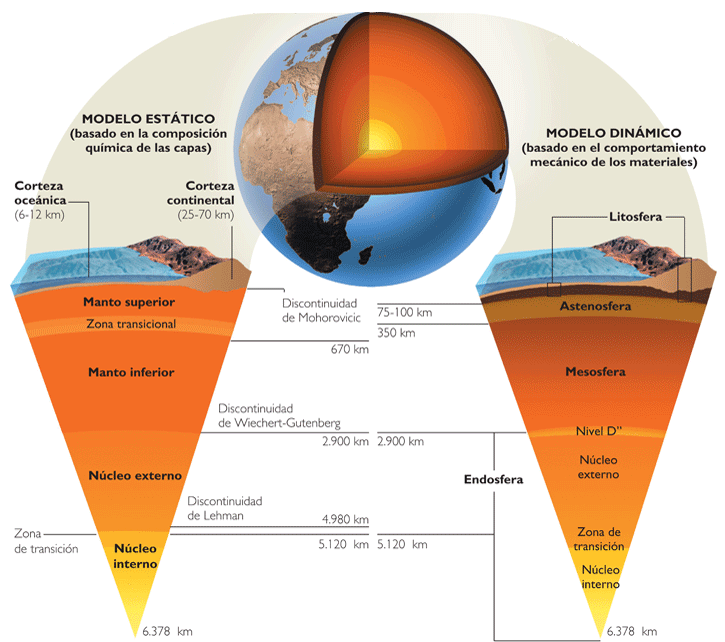Plate tectonics |
 |
In our days, the effective theory that explains the movement of the continents is plate tectonics. These are its basical concepts:
- Our planet's outer geological layer is called litosphere. It's a discontinuous layer fragmented in plates that fit together.
- Most of the geological activity takes place in the limits between plates.
- Oceanic litosphere is thinner than continental.
- At the same time the lithospere is formed in the oceanic ridges, it melts in the subduction zones.
- The movement of the plates produces the movement of the continents.
- The oceans are formed in the zones of separation between plates, and and the mountain ranges appear contact zones between boards.
1.- Earth's inner structure:
Nowadays there are two models that explain the estructure of our planet:
- Geochemical or static model: it's based on the study of sismical waves. The zone in wich the properties of waves change is called geological discontinuity. According to this model, the planet is composed of three well differentiated areas:
- Crust: it has variable thickness, around 30 kilometres. Two classes of crust can be distinguished: the thick and light continental crust and the dense and fine oceanic crust.
- Mantle: it borders on the crust on the Mohorovicic discontinuity. It is 2900 kilometres thick, and it's composition is similar to a peridotite's.
- Core: it borders on the mantle on the Gutemberg discontinuity, also called "D zone". It is a sphere with a radius of 3471 kilometers, composed of heavy elements such as iron and nickel. It is thought to be in liquid state.
- Dinamic model: it tries to explain the movement of litospheric plates. Traditionally, this model divided the Earth in three parts, but the scientists have realized that one of them, the asthenosphere, is not a continuous layer, and for that reason it is no longer included in the model. So, this model fragments the planet in:
- Litosphere: it is a rigid and fragmented layer that includes the crust and the upper section of the mantle (up to 100 km deep)
- Mesosphere: it is the layer located right below the litosphere. Its lower bound is 2900 km deep. It's the layer where convection currents are formed.
- Endosphere: it is the innermost layer of our planet. It is a sphere whose center is 6370 km deep and whose surface in not regular due to convection currents that take place in it.

Subir